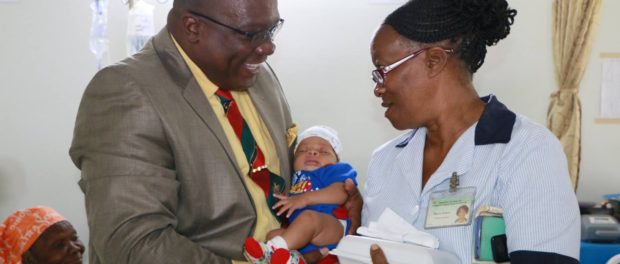JNF GENERAL HOSPITAL TAKING STEPS TO BECOME A BABY FRIENDLY HOSPITAL
Get our headlines on WHATSAPP: 1) Save +1 (869) 665-9125 to your contact list. 2) Send a WhatsApp message to that number so we can add you 3) Send your news, photos/videos to times.caribbean@gmail.com

Basseterre, St. Kitts, August 16, 2019 (SKNIS): The JNF General Hospital has been taking steps to become certified as a baby friendly hospital, says Nurse Naomi Brownbill, Staff Nurse at JNF Hospital Nursery as well as Breastfeeding Coordinator, adding that there are 10 steps that will be followed to achieve their goal.
Appearing on the radio-television show “Working for You” on August 14, 2019, Nurse Brownbill made mention of a few of those steps. She stated that the steps are broken down into critical management procedures and key clinical practices.
The first step outlined was under critical management procedures. Nurse Brownbill noted that the first step comprises three parts, which include complying fully with the international code of marketing of breastmilk substitutes and relevant world health assembly resolutions; having a written infant feeding policy that is routinely communicated to staff and parents; and establishing ongoing monitoring and data management systems.
“So far, they have drafted a breastfeeding policy,” said Nurse Brownbill. “This policy will promote breastfeeding. It does not support the feeding of infants formulas in the bottles or teats. It also protects mothers who cannot breastfeed and those who might not want to breastfeed. Although you might educate, they might stand firm and still say they are not breastfeeding. So, you still have to have something in place for these persons because it’s their right.”
The nurse stated that this policy is hoped to be achieved by November of this year. The policy will be distributed to community nurses and all units at the JNF General Hospital. It is also being done at the Alexandra Hospital in Nevis, which will also distribute this policy to the different units.
The second step mentioned is to ensure that the staff has sufficient knowledge, competence and skills to support breastfeeding.
“We have already started meeting this as we have already started training staff,” said Nurse Brownbill. “When we say ‘staff’ we mean everybody including the gardeners, the maintenance, the lab technicians, expert technicians, the nurses, the doctors, everybody. We also have our assessment tool. So, we assess to see if these workers have sufficient knowledge that we expect them to know about breastfeeding. So, we do our teaching and we do assessment as to staff knowledge.”
Step three is the first step under the key clinical practices, said Nurse Brownbill.
“It says discuss the importance and management of breastfeeding with pregnant women and their families. This is something that we do all the time. We do it at community levels, we do it at the doctor’s office, and we also do it at the hospital. So, our mothers are educated on the importance of breastfeeding for their babies and also themselves because we let them know what the benefits are to them as well. They are also prepared on how to feed because with some mothers it comes naturally, with other mothers you have to teach them how it’s done. This is done in the community, in institution hospitals, and in the private sector,” she said.
The nurse stated that in teaching mothers how to breastfeed they will understand how to care for their breasts, how to prepare their breasts, and how to store the milk amongst other things.
Nurse Brownbill stated that step four is to facilitate immediate and uninterrupted skin-to-skin contact, and to support mothers to initiate breastfeeding as soon as possible after birth.
“This is a step that we have already fulfilled,” she said. “Our goal is to have at least 90 percent of our cases being breastfed as that is a requirement for certification, that is, having skin-to-skin contact, and we are almost there.
Step five, Nurse Brownbill said, is to support mothers to initiate and maintain breastfeeding and manage common difficulties. She stated that mothers are taught different positions for breastfeeding, how to properly attach the baby to the breast, and how to know when the baby is properly attached to the breast.
“We also assist them with common breastfeeding problems,” she said. “For instance, even though we might teach them how to latch on the baby, they might not get it done properly. So we assist them with getting it done. We might teach them different positions, but they are not getting the different positions properly. So, we have to assist them as to how to position the baby properly and so forth. This is something that we do 24/7 at the maternity and nursery unit.”
The last step mentioned was to not to allow any food or fluids other than breastmilk to the new-borns unless medically indicated.
“At all our institutions all our babies are breastfed on demand,” said Nurse Brownbill. “We only provide substitute feeds if it is prescribed by a doctor and we treat it the same as medication and although it is prescribed by a doctor we still get the parents’ consent before we give it.”
Leave a comment
You must be logged in to post a comment.